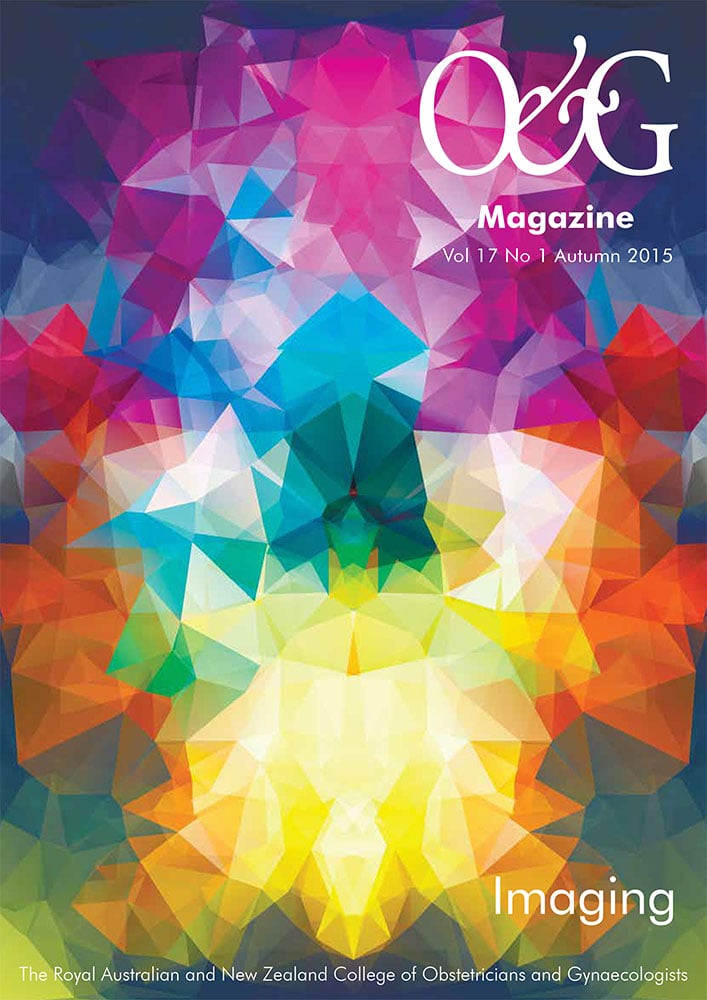Gynaecology can be one of the most rewarding areas to work in, with many opportunities to contribute to clinical care and perform interesting, complex, minimally invasive interventions. It has be a leading model for joint-speciality research, with the results producing significant benefits for patients and doctors.
Interventional radiology (IR) is changing rapidly, with sub-specialty status now recognised in Europe and North America. In Australasia, IR has introduced the European Board exit exam (EBIR) as part of a similar journey to sub-specialty status. The changes reflect the clinical role IR now plays in hospital medicine. Image-guided interventions in gynaecology, as in all specialities, often require peri-procedural clinical support by IR to facilitate treatment planning.
Percutaneous treatment of pelvic collections
Percutaneous image-guided aspiration and drainage of abdominal and pelvic collections are the most common procedures provided by IR departments. Ultrasound (US) and computed tomography (CT) are the workhorse modalities for these procedures, but fluoroscopy and magnetic resonance imaging (MRI) can be used, depending on patient pathology and department resources. Many IR departments will have standard requirements for patient preparation, including nil by mouth for two-to-four hours before, and a recent international normalised ratio (INR) of less than 1.5. These parameters can at times appear unnecessary; however, providing a reliable and timely aspiration and drainage service across all referring specialities is easiest with consistent guidelines that are simple to follow. Clinical discussion with IR about individual patient management will often allow procedures to be performed outside these guidelines.
In gynaecology, post-operative collections, tubo-ovarian abscess and, on occasion, ovarian cysts, require aspiration or drainage. Percutaneous access is usually via an anterior transabdominal approach, but transgluteal, endo-vaginal or endo-rectal approaches are also used. Endo-vaginal drainage is performed using US, with needle guide equipment to allow precise targeting of the collection and avoidance of non-target injury to bowel, blood vessels and other structures including ureters. Most procedures can be performed under conscious sedation, but in our department we prefer general anaesthesia for transvaginal procedures to improve patient tolerance and comfort. Up to 75 per cent of postoperative collections can be successfully managed with percutaneous drainage alone. In the rare circumstance where ovarian cyst aspiration is considered, recurrence of the cyst can occur in up to 60 per cent of patients and, in our practice, repeat aspiration is rarely indicated. Minor complications, including transgression of bowel or bladder, and bleeding occur in up to ten per cent of patients following drainage, but rarely result in significant morbidity.1
Advanced IR techniques can allow patients with challenging anatomy for image-guided percutaneous drainage to be treated. ‘Hydrodissection’ involves placing a small needle adjacent to bowel, or other non-target structures at risk of injury, and injecting normal saline or five per cent dextrose to push these structures away and allow access to the target lesion or collection. Hydrodissection fluid is most often opacified with contrast when performed under CT to differentiate dissection fluid from haematoma.
For patients with malignant ascites, common in ovarian and endometrial carcinoma, repeat ultrasound-guided aspiration or drainage can be required. If recurrent admissions to hospital are significantly impacting a patient’s quality of life, then placement of a tunnelled drainage catheter or ‘port’ by IR can allow for outpatient management with community-nurse-facilitated aspiration via the port, as clinically required. IR departments now place a large number and variety of ports, including central venous access or Portacath’s for chemotherapy and subcutaneous ports with catheters in malignant pleural and ascitic effusions, to allow simple needle access for repeat outpatient aspiration. The complication rates may be slightly lower and patient recovery faster, when compared to surgically placed ports.2
Management of acute and chronic haemorrhage
IR can provide alternative treatment options for patients with uterine and vaginal bleeding, in both acute and chronic settings. Drs Allan, Robson and Tamhame discuss this in further detail in the following article.
Uterine arterio-venous malformations (AVM) are most frequently the result of recent uterine instrumentation and likely represent traumatic myometrial arterio-venous fistulas. There is no well-established algorithm for deciding between conservative and interventional management. In our department, patients admitted with significant menorrhagia requiring transfusion or repeated admissions with anaemia are considered candidates for embolisation, as are patients with a progressive or non-involuting AVM on Doppler US after three or four menstrual cycles. We perform the initial embolisation with a temporary agent (Gelfoam), with the expectation that the majority of AVMs will occlude and re-model to normal myometrium. With this approach, recurrence of the AVM occurs in up to 15 per cent of patients, sometimes owing to ovarian-uterine collaterals and repeat embolisation can be considered with a permanent embolic agent, such as Histoacryl glue (‘superglue’).
Uterine artery embolisation
Uterine artery embolisation (UAE) is an established, minimally invasive treatment option for symptomatic uterine fibroids. Short-term safety and efficacy are well documented and long-term follow-up from randomised controlled trials has been published more recently.3 4 5 Following successful embolisation (>99 per cent infarcted), fibroids will reduce in volume year on year through to five years and beyond. Compared with myomectomy, there is a reduced risk of new fibroids growing by year five. However, there is a price to pay for the benefits sought by choosing a minimally invasive treatment, with faster recovery and fewer major complications.6 For fibroids that are incompletely infarcted (<90 per cent devascularisation), between 17 and 32 per cent of women will require re-intervention in the five years following embolisation.7 8 Hysteroscopic curettage or resection of endocavitary fibroids can be required in the first 12 months following embolisation and for women with recurrence of symptoms re-intervention with repeat embolisation, myomectomy or hysterectomy can be required. These clinical data will allow gynaecologists and IRs to inform women about realistic expectations for different uterine-preserving treatments options.
Fertility following UAE remains a controversial area, with a paucity of robust clinical data with which to guide patients.9 10 While pregnancy following UAE has been widely reported, the impact of embolisation on fertility remains unclear. The current guidelines reflect this, advising that women who want to preserve future fertility should be offered myomectomy first where there is a reasonably low risk of hysterectomy, but for women who are not surgical candidates it is reasonable to offer UAE. To better clarify the relative impact of UAE and myomectomy on fertility, the FEMME study in the UK has been designed as a multicentre randomised trial comparing UAE with myomectomy in 650 women. The primary outcome measure is quality of life, with secondary endpoints including pregnancy outcomes, further treatment, adverse events and ovarian function. This was recruited to 94 per cent at the end of 2014, but will not look to publish outcomes until two-year follow-up data are available, so there is still some wait before this important information is available to guide doctors and patients.
Helping solve clinical problems using image-guided intervention is a real motivation for IRs, oftentimes as the last port of call, but occasionally it’s worth popping in early on just to see what might be possible.
References
- Saokar, A, Arellano, RS, Gervais, DA, Mueller, PR, Hahn, PF, & Lee, SI. (2008). Transvaginal Drainage of Pelvic Fluid Collections: Results, Expectations, and Experience. AJR American Journal of Roentgenology. 191(5), 1352-1358. doi:10.2214/AJR.07.3808.
- Stokes, L. (2007). Percutaneous Management of Malignant Fluid Collections. Seminars in Interventional Radiology. 24(4), 398-408. doi:10.1055/s-2007-992328.
- Ananthakrishnan, G, Murray, L, Ritchie, M, Murray, G, Bryden, F, Lassman, S, et al. (2012). Randomized comparison of uterine artery embolization (UAE) with surgical treatment in patients with symptomatic uterine fibroids (REST trial): subanalysis of 5-year MRI findings.
CardioVascular and Interventional Radiology. 36(3), 676-681. - Moss JG, Cooper KG, Khaund A, Murray LS, Murray GD, Wu O, et al. Randomised comparison of uterine artery embolisation (UAE) with surgical treatment in patients with symptomatic uterine fibroids (REST trial): 5-year results. BJOG. 2011 Apr 12;118(8):936-44.]
- van der Kooij SM, Hehenkamp WJK, Volkers NA, Birnie E, Ankum WM, Reekers JA. Uterine artery embolization vs hysterectomy in the treatment of symptomatic uterine fibroids: 5-year outcome from the randomized EMMY trial. AJOG. 2010 Jan 8;203(2):105.e1-105.e13.
- Martin, J, Bhanot, K, & Athreya, S. (2012). Complications and Reinterventions in Uterine Artery Embolization for Symptomatic Uterine Fibroids: A Literature Review and Meta Analysis. CardioVascular and Interventional Radiology. 36(2), 395-402.
- Moss JG, Cooper KG, Khaund A, Murray LS, Murray GD, Wu O, et al. Randomised comparison of uterine artery embolisation (UAE) with surgical treatment in patients with symptomatic uterine fibroids (REST trial): 5-year results. BJOG. 2011 Apr 12;118(8):936-44.
- Dueholm M, Langfeldt S, Mafi HM, Eriksen G, Marinovskij E. Re-intervention after uterine leiomyoma embolisation is related to incomplete infarction and presence of submucous leiomyomas. European Journal of Obstetrics and Gynecology. 2014 Nov 27;:1-7.
- Torre, A, Paillusson, B, Fain, V, Labauge, P, Pelage, JP, & Fauconnier, A. (2014). Uterine artery embolization for severe symptomatic fibroids: effects on fertility and symptoms. Human Reproduction. 29(3), 490-501.
- Sirkeci F, Narang L, Naguib N, Belli A-M, Manyonda IT. Uterine artery embolization for severe symptomatic fibroids: effects on fertility and symptoms. Human Reproduction. 2014 Aug;29(8):1832-3.






Leave a Reply